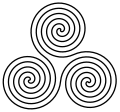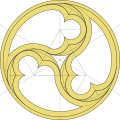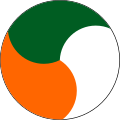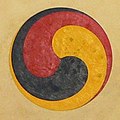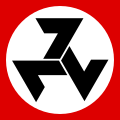
The triskelion symbol appears in many early cultures, the first in Malta (4400–3600 BCE) and in the astronomical calendar at the famous megalithic tomb of Newgrange in Ireland built around 3200 BCE, Mycenaean vessels, on coinage in Lycia, and on staters of Pamphylia (at Aspendos, 370–333 BCE) and Pisidia. It appears as a heraldic emblem on warriors’ shields depicted on Greek pottery.
The triskelion is an ancient symbol of Sicily, with the head of the Gorgon, with snakes as hair, from which radiate three legs bent at the knee. The symbol dates back to when Sicily was part of Magna Graecia, the colonial extension of Greece beyond the Aegean. Pliny the Elder attributes the origin of the triskelion of Sicily to the triangular form of the island, the ancient Trinacria (from the Greek tri- (three) and ἄκρα akra (end, peak, citadel), which consists of three large capes equidistant from each other, pointing in their respective directions, the names of which were Pelorus, Pachynus, and Lilybæum.
The Celtic symbol of three conjoined spirals may have had triple significance similar to the imagery that lies behind the triskelion. The triple spiral motif is a Neolithic symbol in Western Europe. Though popularly considered a “Celtic” symbol, it is in fact a pre-Celtic symbol.[10] It is carved into the rock of a stone lozenge near the main entrance of the prehistoric Newgrange monument in County Meath, Ireland. Newgrange, which was built around 3200 BCE,[6] predates the Celtic arrival in Ireland, but has long since been incorporated into Celtic culture. The symbol is also found carved in rock in Castro Culture settlement in modern-day Galicia and Northern Portugal. In Ireland before the 5th century, in Celtic Christianity the triskele took on new meaning, as a symbol of the Trinity(Father, Son, and Holy Spirit), and therefore also a symbol of eternity. Its popularity continues today as a decorative symbol of faith for Christians of Celtic descent around the world.
Modern usage
A triskelion is featured on the seal of the United States Department of Transportation.
A triskelion shape is the basis for the roundel of the Irish Air Corps, and the logo for the Trisquel Linux distribution.
A triskelion shape was used in the design of RCA’s “Spider” 45 rpm adapter, a popular plastic adapter for vinyl records, which allows larger center-holed 45 rpm records (commonly used on 7″ singles and EPs) to spin on players designed for smaller center-holed 33-1/3 rpm records (the standard for 10″ and 12″ LPs). The design was practical, the three curved arms providing equal spring and thus keeping the hole centred. The iconic design of the Spider has led to its adoption as a popular symbol for record and music enthusiasts.
One of the most commonly used symbols of the BDSM community is a derivation of a triskelion shape within a circle.
The South African neo-Nazi White supremacist White nationalist organization and political party Afrikaner Weerstandsbeweging uses a Triskele composed of three sevens as its symbol in place of the Nazi Swastika.
The Flag of the Isle of Man bears 3 legs based on the Triskele.
The crest of the Breton football club En Avant de Guingamp combines the Flag of Brittany, the team colours and the triple spiral triskelion.
“The Gamesters of Triskelion” is a second-season episode of the American science fiction television series Star Trek.
In the Marvel Universe, the intelligence agency S.H.I.E.L.D. uses the Triskelion as its headquarters.
The Triskele is also used as a prominent symbol in MTV’s “Teen Wolf (2011 TV Series)” which draws heavily from Celtic mythology. A Triskele was used by some younger betas to keep from shifting & maintain calm. This happens by the beta repeating “Alpha, Beta, Omega” or “The Sun, The Moon, The Truth” over and over again until the beta is calm.
In Merlin (2008 TV series) it was used as symbol of druids.
Reconstructionists and neopagans

Abbatial church of Saint-Antoine-l’Abbaye with a group of 3 triskelions (in Isère / France)

On the front of Abbatial church of Saint-Antoine-l’Abbaye with 2 groups of 2 triskelions and 1 biskel (in Isère / France)

The flag of Sicily, featuring the triskelion symbol and the Gorgon

The flag of the Isle of Man, is composed solely of a triskele against a red background

Flag of Ust-Orda Buryat Okrug
The triskelion symbol appears in many early cultures, the first in Malta (4400–3600 BCE) and in the astronomical calendar at the famous megalithic tomb of Newgrange in Ireland built around 3200 BCE, Mycenaean vessels, on coinage in Lycia, and on staters of Pamphylia (at Aspendos, 370–333 BCE) and Pisidia. It appears as a heraldic emblem on warriors’ shields depicted on Greek pottery.
The triskelion is an ancient symbol of Sicily, with the head of the Gorgon, with snakes as hair, from which radiate three legs bent at the knee. The symbol dates back to when Sicily was part of Magna Graecia, the colonial extension of Greece beyond the Aegean. Pliny the Elder attributes the origin of the triskelion of Sicily to the triangular form of the island, the ancient Trinacria (from the Greek tri- (three) and ἄκρα akra (end, peak, citadel), which consists of three large capes equidistant from each other, pointing in their respective directions, the names of which were Pelorus, Pachynus, and Lilybæum.
The Celtic symbol of three conjoined spirals may have had triple significance similar to the imagery that lies behind the triskelion. The triple spiral motif is a Neolithic symbol in Western Europe. Though popularly considered a “Celtic” symbol, it is in fact a pre-Celtic symbol. It is carved into the rock of a stone lozenge near the main entrance of the prehistoric Newgrange monument in County Meath, Ireland. Newgrange, which was built around 3200 BCE, predates the Celtic arrival in Ireland, but has long since been incorporated into Celtic culture. The symbol is also found carved in rock in Castro Culture settlement in modern-day Galicia and Northern Portugal. In Ireland before the 5th century, in Celtic Christianity the triskele took on new meaning, as a symbol of the Trinity (Father, Son, and Holy Spirit), and therefore also a symbol of eternity. Its popularity continues today as a decorative symbol of faith for Christians of Celtic descent around the world.
Asian usage
Traditional Asian versions of the triskelion include the Japanese Mitsudomoe, the Tibetan Buddhist Gankyil, and the Korean Sam Taegeuk.
Modern usage
A triskelion is featured on the seal of the United States Department of Transportation.
A triskelion shape is the basis for the roundel of the Irish Air Corps,] and the logo for the Trisquel Linux distribution.
A triskelion shape was used in the design of RCA’s “Spider” 45 rpm adapter, a popular plastic adapter for vinyl records, which allows larger center-holed 45 rpm records (commonly used on 7″ singles and EPs) to spin on players designed for smaller center-holed 33-1/3 rpm records (the standard for 10″ and 12″ LPs). The design was practical, the three curved arms providing equal spring and thus keeping the hole centred. The iconic design of the Spider has led to its adoption as a popular symbol for record and music enthusiasts.
One of the most commonly used symbols of the BDSM community is a derivation of a triskelion shape within a circle.
The South African neo-Nazi White supremacist White nationalist organization and political party Afrikaner Weerstandsbeweging uses a Triskele composed of three sevens as its symbol in place of the Nazi Swastika.
The Flag of the Isle of Man bears 3 legs based on the Triskele.
The crest of the Breton football club En Avant de Guingamp combines the Flag of Brittany, the team colours and the triple spiral triskelion.
“The Gamesters of Triskelion” is a second-season episode of the American science fiction television series Star Trek.
In the Marvel Universe, the intelligence agency S.H.I.E.L.D. uses the Triskelion as its headquarters[citation needed].
The Triskele is also used as a prominent symbol in MTV’s “Teen Wolf (2011 TV Series)” which draws heavily from Celtic mythology. A Triskele was used by some younger betas to keep from shifting & maintain calm. This happens by the beta repeating “Alpha, Beta, Omega” or “The Sun, The Moon, The Truth” over and over again until the beta is calm.
In Merlin (2008 TV series) it was used as symbol of druids.
Reconstructionists and neopagans
The triskele, usually consisting of spirals, but also the “horned triskelion”, is used by some polytheistic reconstructionist and neopagan groups. As a Celtic symbol, it is used primarily by groups with a Celtic cultural orientation and, less frequently, can also be found in use by various eclectic or syncretic traditions such as Neopaganism. The spiral triskele is one of the primary symbols of Celtic Reconstructionist Paganism. Celtic Reconstructionists use the symbol to represent a variety of triplicities in their cosmology and theology; it is also a favored symbol due to its association with the god Manannán mac Lir.
Occurrence in nature
The endocytic protein, clathrin, is triskelion-shaped. The Ediacaran fossil Tribrachidium is also triskelion shaped.
Gallery
-
Triskelion of Sicily of the Minoan period (archaeological museum of Agrigento)
-
Spiral triskele, found in Celtic artwork, used by Celtic Reconstructionists and occasionally as a Christian Trinity symbol
-
The BDSM community’s triskele-type emblem.
-
Irish Air Corps roundel. A modern interpretation of the Celtic triskele
-
Iron Age Castro culturetriskele, reused in a barn. Airavella, Allariz, Galicia
-
The seal of the US Department of Transportation.
-
Coat of Arms of Füssen
-
The seal of Tau Gamma Sigma sorority
-
Slinger standing left, triskelion to right. Reverse of an ancient Greek silver stater from Aspendos, Pamphylia.
-
Triskelion and spirals on a Galician torcterminal.
-
The Korean Sam Taegeuk
-
Insignia of the 27th SS Volunteer Division Langemarck
-
The emblem of the South African Afrikaner Weerstandsbeweging
-
Logo of Trisquel GNU/Linux
-
Clathrin triskelion highlighted
Triple Spiral (Triskele) Symbol Meaning:
This is another trinity symbol often found among ancient Celtic relics. It is sometimes referred to as a triskelion. The terms are often considered synonymous. This Celtic symbol meaning deals with the drawing of the three powers of maiden, mother and crone. It is often considered a sign of female power and especially power through transition and growth. This, however, is not an exclusive definition. Sometimes the symbol represents religious aspects of Father, Son, Holy Ghost. This representation came much later amongst Celtic descendants who were exposed to Christian conversion. In any instance, this trinity symbol can represent a triangle of foundational necessity. Meaning – you cannot have a healthy whole without all three elements joined together. Hence: Mind, Body, Spirit. Sun, Moon, Earth. Light, Dark, Gloaming (twilight). Not one energy can exist without the others.




